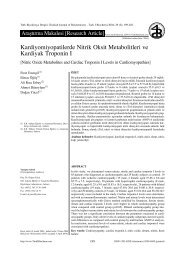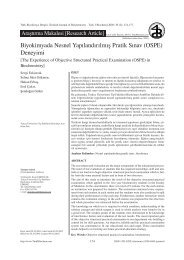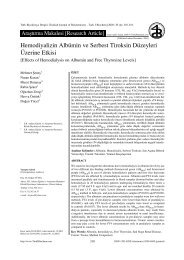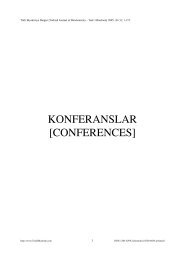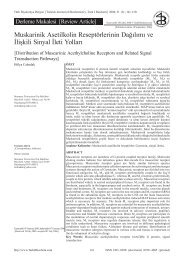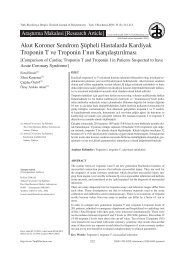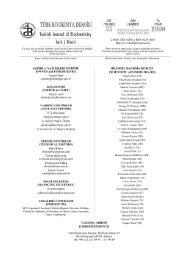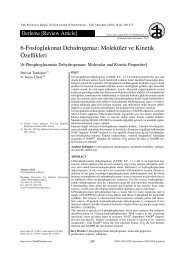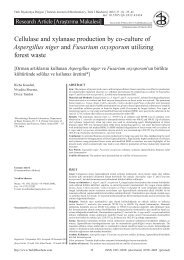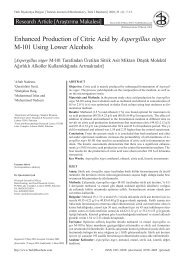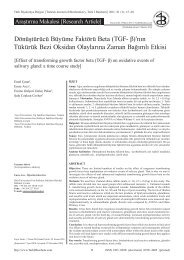24. Ulusal Biyokimya Kongresi - Türk Biyokimya Dergisi
24. Ulusal Biyokimya Kongresi - Türk Biyokimya Dergisi
24. Ulusal Biyokimya Kongresi - Türk Biyokimya Dergisi
- No tags were found...
You also want an ePaper? Increase the reach of your titles
YUMPU automatically turns print PDFs into web optimized ePapers that Google loves.
XXIV. ULUSAL B‹YOK‹MYA KONGRES‹<br />
25 - 28 Eylül 2012<br />
Dedeman Otel - Konya<br />
<strong>24.</strong> <strong>Ulusal</strong> <strong>Biyokimya</strong> <strong>Kongresi</strong>, Konya [24 th National Biochemistry Congress, Konya / TURKEY]<br />
İÇİNDEKİLER<br />
DAVETLİ KONUŞMACI ÖZETLERİ<br />
27 Eylül 2012, Perşembe / ANA SALON<br />
FOLAT ARACILI TEK KARBON METABOLİZMASININ<br />
DÜZENLENMESİ VE NÖROBİYOKİMYADAKİ YERİ<br />
Mustafa GÜLTEPE<br />
GATA Haydarpaşa Eğitim Hastanesi Tıbbi <strong>Biyokimya</strong> Bölümü, İSTANBUL<br />
Tetrahidrofolat poliglutamatlar, tek karbon birimlerini taşıyan ve kimyasal olarak<br />
aktive eden kofaktör ailesidir. Aktiflenmiş tek karbonlar, pürin ve timidilatın<br />
molekül biyosentezlerinde ve metyoninin tekrar metilasyon yoluyla homosisteinden<br />
sentezinde görev alırlar. Metyonin, adenozil metyonine aktiflenerek metilasyon<br />
reaksiyonlarının kaynağını oluşturur.<br />
Tek karbonlar, diğer ifade ile metil gruplarının üç önemli özelliğini vurgulayabiliriz.<br />
Birincisi, küçük moleküllerdir, ikincisi, çoğunlukla hidrofobik özellik taşırlar,<br />
üçüncüsü ise, amino asitlerce taşınabilirler. Bu özellikler, başka moleküllerin<br />
sentezi ve modifikasyonu için kullanışlıdır.<br />
Folat moleküllerinin önemli bazı özelliklerini ise şöyle sıralayabiliriz; 1.<br />
oksidasyona çok duyarlı olmaları, 2. oksidasyon düzeyleri arasında geçiş<br />
yapabilmeleri, 3. hücrenin oksidasyon potansiyeli ile yönlendirilmeleri, 4.tek<br />
karbonların N5 ve N10 arasında taşınma verimliliği gibi.<br />
Tek karbon metabolizmasının sürdürülebilirliği ile ilgili önemli kanıtlar elde<br />
edilmektedir. Folat bünyesindeki aktif metil gruplarının oksidasyon düzeyini<br />
değiştiren enzimler, akışı yönlendirmektedir. Ayrıca, homosistein remetilasyonu<br />
ve fosfolipid metilasyonu dengeye katkı sağlamaktadır.<br />
Tek karbon döngülerinin bozulması ile nörobiyokimyasal metabolizmada önemli ve<br />
çeşitli hastalıklar ortaya çıkmaktadır. Metilasyon bozuklukları ve nörotransmitter<br />
sentezinde yetmezlikler önemlidir. Tetrahidrobiopterin metabolizması ile ilişkiler<br />
de dikkat çekicidir.<br />
REGULATION OF FOLATE MEDIATED ONE-CARBON PATHWAYS<br />
AND THE IMPORTANCE FOR THE NEUROBIOCHEMICAL<br />
METABOLISM<br />
Mustafa GÜLTEPE<br />
GATA Haydarpaşa Training Hospital, Biochemistry Department, ISTANBUL<br />
One carbon units are carried and are chemically activated by tetrahydrofolate<br />
polyglutamates that are family of cofactors. Activated one carbon units involve<br />
in de novo thymidylate and purine biosynthesis and in the synthesis of the<br />
methionine by the remethylation of homocysteine. Adenosylmethionine sourced<br />
of methylation reactions is formed from methionine that is activated.<br />
Chemical structures of the methyl groups, have three important characteristics.<br />
First, they are small molecules, second, the majority of them have hydrophobic<br />
feature, third, they can be transported by amino acids. These features are convenient<br />
for the other molecules that will be synthesis and chemical modifications.<br />
On the other hand, some features of the folate molecules are; 1. they are very<br />
sensitive by the oxidation, 2. they are passing between at the different oxidation<br />
levels, 3. they are directed by the oxidation potential of the cell, 4. they carry the<br />
methyl groups easily between the N5 and N10 atoms.<br />
Very important evidences have been appeared recently about the regulation on<br />
the one carbon metabolism. The enzymes changing the oxidation levels of the<br />
methyl groups on the folate cofactors, participate for the regulation. In addition,<br />
remethylation of homocysteine and the methylation of phospholipids give the<br />
contribution for the regulation.<br />
Several diseases appeared in neurobiochemical metabolism originated from<br />
disregulation of the one carbon pathways, for example, dearrangement of<br />
methylations and the decreases for neurotransmitters synthesis. Also, the<br />
relationships with the tetrahydrobiopterin metabolism are taken into consideration<br />
recently.<br />
CONTENTS<br />
ABSTRACTS OF INVITED LECTURES<br />
Turk J Biochem, 2012; 37 (S1)<br />
http://www.TurkJBiochem.com



